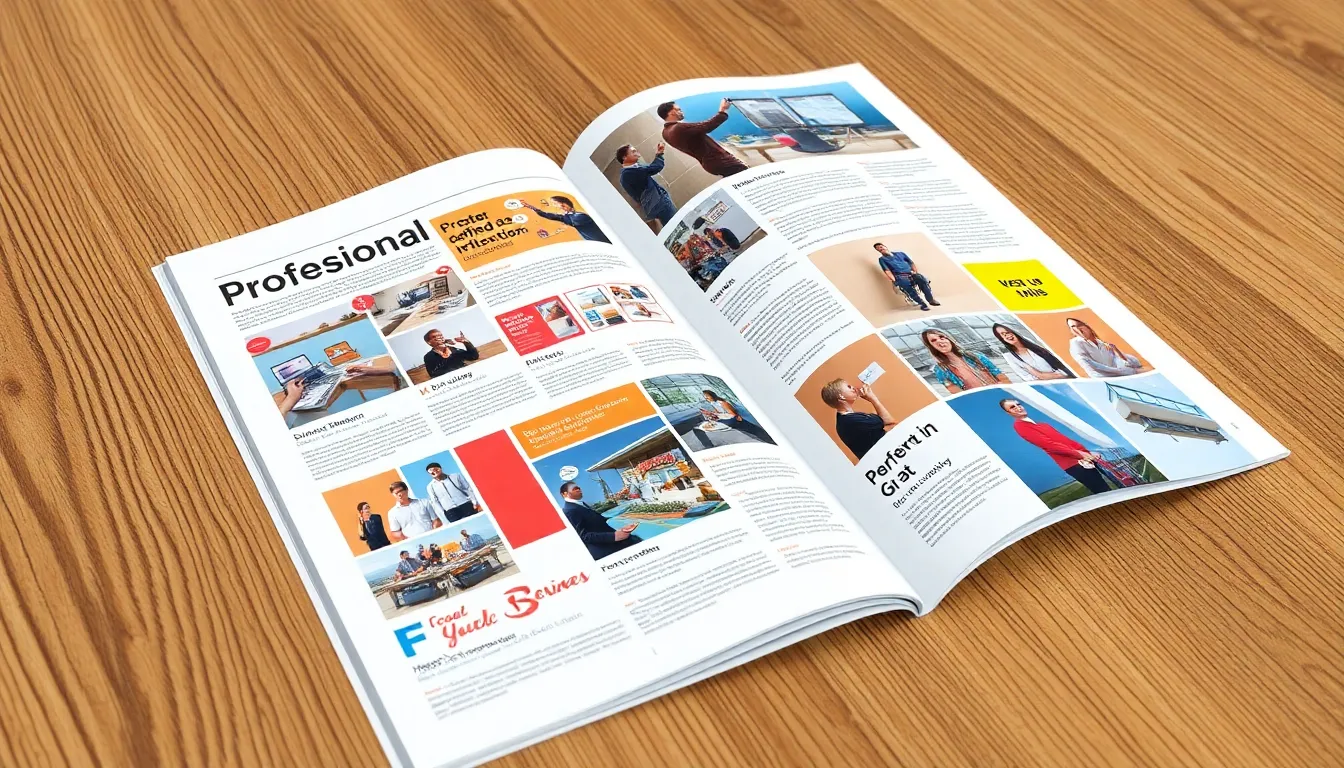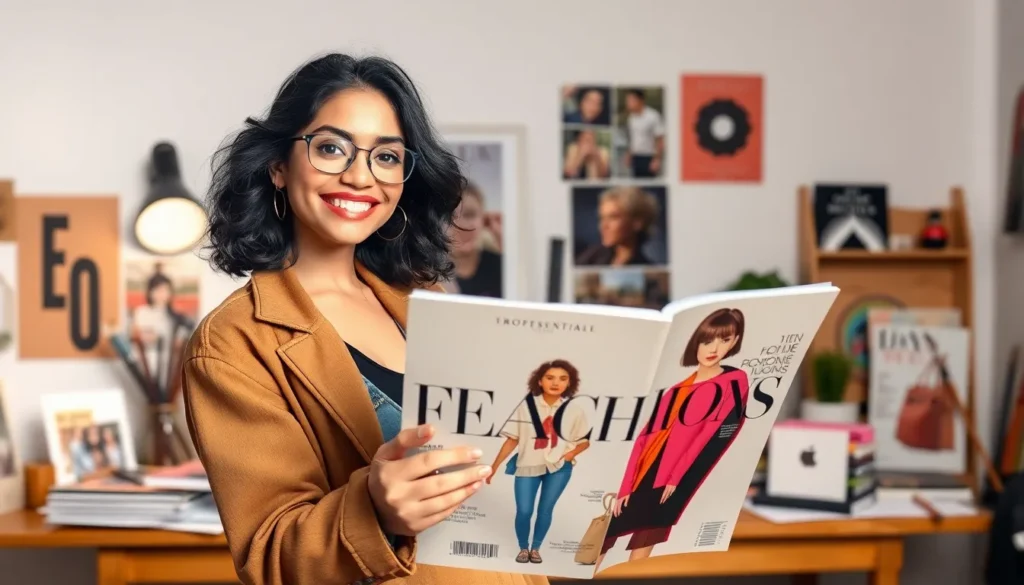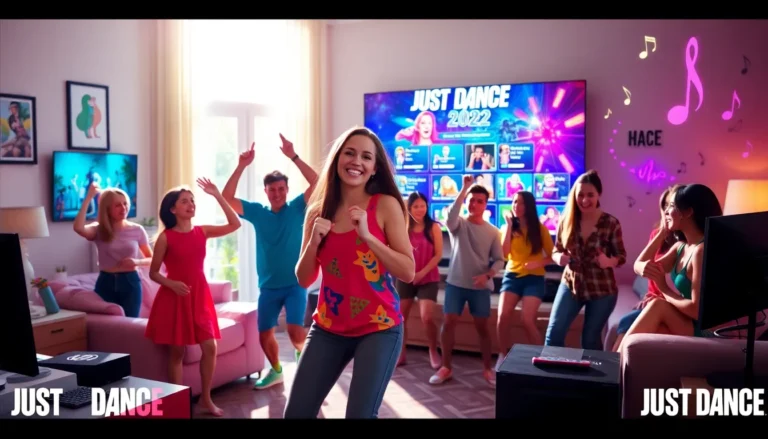In a world overflowing with digital noise, vibrant magazine visuals cut through the clutter like a hot knife through butter. They don’t just grab attention; they hold it hostage, demanding viewers stop scrolling and take notice. Imagine flipping through a magazine where each page bursts with color, creativity, and captivating imagery. It’s not just about looking good; it’s about making an unforgettable impression.
These visuals are the secret sauce that can elevate a magazine from mundane to magnificent. They tell stories, evoke emotions, and even spark conversations—who knew a picture could be so chatty? Whether it’s bold typography or stunning photography, vibrant visuals transform ordinary content into an extraordinary experience. Dive into the world of magazine design, where every page is a canvas waiting to inspire and ignite imagination.
Table of Contents
ToggleOverview of Vibrant Magazine Visuals
Vibrant magazine visuals play a crucial role in attracting readers’ attention. Such visuals encompass bold typography, stunning photography, and striking illustrations that enhance a publication’s overall aesthetic. Attention-grabbing colors and innovative layouts engage readers and create a memorable experience.
Stunning visuals serve not only as eye candy but also as storytelling devices. Photographs that capture raw emotions or illustrations that depict concepts can provoke thought and spark discussions. Magazine designers utilize visual elements to evoke specific feelings, ensuring the content resonates deeply with the audience.
Diverse design techniques also contribute to the effectiveness of magazine visuals. Incorporating white space allows for better focus on key images and text. Layering visuals creates depth and interest, encouraging readers to explore each page. Moreover, high-quality images elevate a magazine’s perceived value, reinforcing credibility and professionalism.
Vibrant magazine visuals also adapt well to digital formats. Interactive elements, such as videos or animated graphics, enhance engagement on online platforms. These innovations cater to evolving reader preferences, ensuring magazines remain relevant in a fast-paced digital landscape. Ultimately, vibrant visuals remain an essential aspect of magazine design, consistently influencing how stories are told and experienced.
Importance of Visuals in Magazines

Visuals play a crucial role in magazine design. They not only capture attention but also foster a deeper connection with the content.
Enhancing Reader Engagement
Vibrant visuals boost reader engagement significantly. High-quality images and bold illustrations attract eyes and spark curiosity. Eye-catching designs can lead to longer reading times, as they invite deeper exploration. Research shows that articles with images receive 94% more views than text-only content. These visuals encourage emotional responses, prompting readers to share and discuss what they see. Creative use of colors and layouts establishes a captivating flow that guides attention seamlessly across pages. Engaging visuals create memorable experiences, drawing readers back to the publication.
Communicating Brand Identity
Visual elements are essential for conveying brand identity. Consistent imagery reinforces a magazine’s unique voice and tone. The choice of colors, fonts, and styles sets a specific atmosphere, connecting with target audiences. A well-defined visual strategy enhances brand recognition, making a magazine instantly identifiable among competitors. Strong visuals can evoke specific feelings that resonate with readers, fostering loyalty and trust. They illustrate brand values through storytelling, allowing readers to relate personally. A coherent visual identity not only attracts new readers but also solidifies the connection with existing audiences.
Key Elements of Vibrant Magazine Visuals
Vibrant magazine visuals rely on several key elements that elevate their design and impact. These components include color schemes, typography choices, and image quality, all working together to captivate readers.
Color Schemes and Palettes
Color schemes significantly influence magazine visuals. Bright, bold colors catch attention and evoke emotions while establishing brand identity. Combining complementary colors enhances reader engagement and creates visual harmony. Magazines often employ contrasts to draw focus to specific elements, such as headlines or images. Consistency throughout the issues strengthens familiarity, making the magazine easily recognizable.
Typography Choices
Typography plays a crucial role in conveying tone and maintaining consistency. Using a mix of font styles creates visual interest without overwhelming readers. Large, bold fonts capture attention in headlines, while smaller, easy-to-read fonts ensure clarity in body text. Magazines often choose typography that reflects their brand identity, reinforcing their message and aesthetic. Adaptable typography across digital formats enhances readability and engagement.
Image Quality and Composition
Image quality significantly impacts magazine visuals. High-resolution images communicate professionalism and attract readers. Strategic composition enhances narratives, guiding the audience’s eyes and emotions through layouts. Balanced arrangements utilize white space for clarity, allowing images to stand out. Magazines often focus on storytelling through images, ensuring each photograph or illustration serves a purpose and enhances the overall design.
Examples of Successful Vibrant Magazine Visuals
Vibrant visuals play a crucial role in magazine design, effectively capturing the audience’s attention. Various magazines exemplify successful implementations of this design principle.
Case Study: Fashion Magazines
Fashion magazines like Vogue and Harper’s Bazaar demonstrate the power of vibrant visuals through high-fashion photography. Bold color palettes and striking layouts elevate editorial content. Glossy photos featuring top models against dynamic backdrops engage readers’ emotions, creating a sense of aspiration. Typography choices frequently blend seamlessly with imagery, enhancing the visual experience. Eye-catching advertisements strategically inserted maintain reader focus while reinforcing brand messaging. Consistency in visual style fosters strong brand identity, ensuring recognition across issues. Research shows that vibrant fashion visuals often boost sales of featured products, showcasing their impact on consumer behavior.
Case Study: Lifestyle Magazines
Lifestyle magazines such as Better Homes & Gardens and Elle Decor captivate audiences with vibrant, inviting imagery. Beautifully styled interiors paired with annotations lure readers into engaging with the content. Colorful illustrations accompany recipes and DIY projects, inspiring creativity and connection. Visual storytelling becomes essential, as it unveils relatable narratives and personal experiences. Text and visuals intertwine, providing a cohesive reading experience that enhances retention. Rich imagery often leads to increased social media shares, broadening the magazines’ reach. Overall, these vibrant visuals not only elevate aesthetic appeal but also forge deeper relationships with readers.
Future Trends in Magazine Visual Design
Emerging trends in magazine visual design showcase a shift toward immersive and interactive experiences. Augmented reality (AR) stands as a key component, enabling readers to engage with visuals in dynamic ways. Print publications increasingly incorporate QR codes, linking to digital content that enriches storytelling.
Sustainability plays a pivotal role in current design practices. Eco-friendly materials and processes resonate with environmentally conscious audiences, influencing brand loyalty. Materials sustain quality while aligning with values, enhancing overall reader engagement.
Minimalism continues to gain traction, emphasizing simplicity and functionality in layouts. Clean designs highlight essential content and direct focus to vibrant visuals. High-contrast color palettes enhance readability while still vibrating with energy and interest.
Typography trends are also evolving. Variable fonts allow for greater versatility, helping to convey brand identity effectively. Custom typefaces create unique visual language, drawing readers’ attention and cultivating a distinctive magazine voice.
Data-driven design influences how visuals are selected and utilized. Analytics guide choices in imagery, ensuring alignment with audience preferences. Targeted visuals enhance relevance and drive engagement, reinforcing personal connections with content.
Collaborative efforts among artists and designers enrich visual storytelling. Cross-disciplinary partnerships yield innovative aesthetics that captivate diverse audiences. Unique perspectives challenge traditional norms, fostering creativity in magazine design.
As technology continues to evolve, responsive design becomes essential. Adapting visuals across digital and print formats ensures consistency in brand presentation. Mobile-friendly layouts cater to increasingly on-the-go readers, accommodating modern lifestyle demands.
These trends collectively shape the future of magazine visual design, ensuring that publications remain relevant and resonant in a rapidly changing landscape.
Vibrant magazine visuals are more than just eye candy; they’re essential tools for engagement and storytelling. By harnessing the power of color typography and high-quality imagery, magazines can create memorable experiences that resonate with readers. As the industry evolves embracing trends like interactivity and sustainability, the role of visuals will only grow in significance.
This dynamic approach not only enhances aesthetic appeal but also fosters a genuine connection with the audience. As magazines continue to adapt to digital landscapes, the importance of vibrant visuals in capturing attention and driving engagement cannot be overstated. Embracing these elements ensures that publications remain not just relevant but also impactful in a competitive market.






